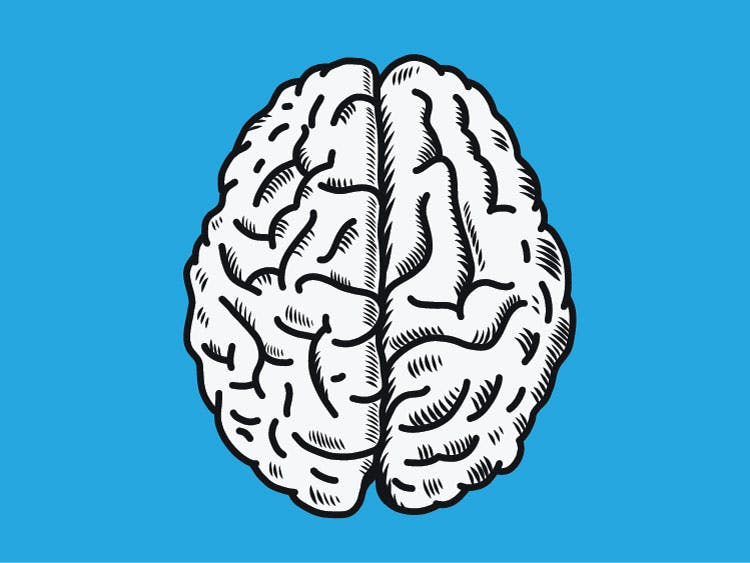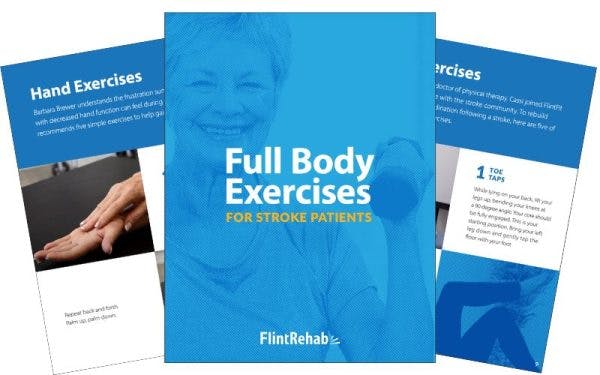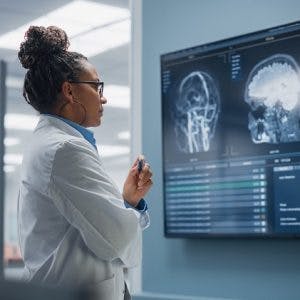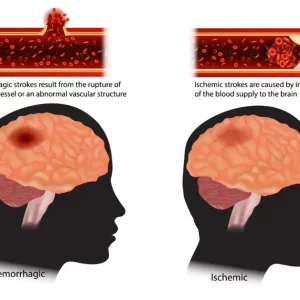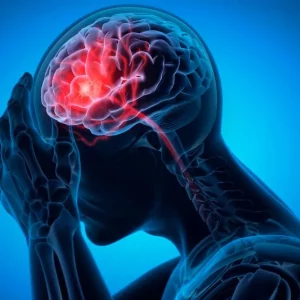A left side stroke is a life-altering event. However, by understanding the unique secondary effects that may occur, you can better optimize recovery. In general, every stroke is different. Yet, certain side effects are more likely after a stroke on the left side of the brain.
In this article we will review the mechanism of a stroke as well as the effects that accompany left side stroke. We will also discuss rehabilitation methods that can help you regain lost function and recover from a stroke on the left side of the brain.
Use the links below to jump straight to any section:
Understanding Left Side Stroke
The left side of the brain, called the left hemisphere, is responsible for a wide variety of motor, sensory, and cognitive functions.
A stroke takes place when blood flow in the brain becomes disrupted by either a blocked artery (ischemic stroke) or burst artery (hemorrhagic stroke). Brain cells that are deprived of oxygen-rich blood can suffer cell death, which is why a stroke is a medical emergency. Common stroke risk factors include high blood pressure, high cholesterol, obesity, and smoking.
As the functions found in the left side of the brain are largely consistent for most individuals, the main resulting effects of tissue damage following left side stroke can also be somewhat predictable. However, even though there are common patterns in left side stroke effects, everyone is unique and will therefore have a unique recovery journey.
A quick response following a left side stroke can minimize damage to brain tissue, reduce the likelihood of severe secondary effects, and even save the life of the individual. Initial stroke symptoms may include drooping of the face, weakness or reduced sensation on one side of the body, slurred speech, and possibly headache.
Learn the warning signs of a stroke and review them to help protect yourself or a loved one that may be at risk.
Want 20 pages of stroke recovery tips in an illustrated PDF? Download our free ebook by clicking here (link opens a pop up for uninterrupted reading)
Secondary Effects of Left Side Stroke
The two hemispheres (halves) of the brain are designated as left and right. Each hemisphere is responsible for functions on the opposite side of the body. For example, the left hemisphere of the brain controls right side body functions and the right hemisphere controls the left side of the body.
Both hemispheres of the brain contain one half of major functional areas such as the frontal lobe, motor cortex, visual cortex, and somatosensory cortex. However, each hemisphere is also home to unique sensory, emotional, and cognitive functions. As a result, a left side stroke can result in a wide array of deficits, although these deficits tend to follow a general pattern. Along with the typical stroke side effects, these are the effects unique to left side stroke:
Right Side Hemiparesis: Weakness on the Right Side of the Body
A stroke in one hemisphere of the brain generally results in motor impairments, such as muscle weakness, on the opposite half of the body. This weakness is defined as hemiparesis and will affect the right side of the body following left side stroke.
Hemiparesis is responsible for many of the functional deficits present after left side stroke. For example, many daily tasks will take more effort and be less efficient as the muscles in the right side of the body are weak and uncoordinated. As a result, many survivors will need adaptive equipment or compensatory techniques until they can regain strength in their right side.
Right Side Hemiplegia: Paralysis on the Right Side of the Body
The severity of weakness depends largely on the size and location of the stroke, as a massive stroke may lead to more severe weakness or paralysis. When left side stroke results in severe damage to the motor cortex, this results in hemiplegia, or paralysis of one side of the body (in this case the right).
Hemiplegia is more widespread and severe than hemiparesis, resulting in greater functional deficits as well as decreased independence for the survivor. For example, paralysis of the right leg impacts or even prevents walking after a stroke. Additionally, paralysis of the arm can drastically affect a survivor’s ability to complete activities of daily living such as bathing, dressing, and toileting.
Aphasia: Difficulty with Language
The language centers of the brain, specifically Broca’s area and Wernicke’s area, reside in the left hemisphere. Consequently, left side stroke survivors often experience language impairments, like aphasia. Aphasia refers to the inability to process or produce language, meaning it can affect speech interpretation as well as speech production. This dramatically affects a survivor’s ability to communicate and can be incredibly frustrating.
There are many different types of aphasia and it’s important to work with a specialist called a speech-language pathologist for an accurate diagnosis and treatment plan. Not all language impairments fall under aphasia, though. There’s also a side effect called apraxia of speech, which we will discuss next.
Apraxia of Speech: Difficulty with Communication
Apraxia is a sound disorder that occurs when control of speech muscles is impaired. With apraxia of speech, patients have difficulty moving the muscles around the mouth due to miscommunication between the brain and muscles. This interferes with the ability to form sounds and words.
Although the individual might know what they want to say cognitively, they cannot get their mouth to form the words correctly. Therefore, this is a motor problem, not a processing problem. This is also different from dysarthria, which is weakness of the muscles used for speech.
Dysphagia: Difficulty Swallowing
Another condition closely tied to language impairment is dysphagia, which refers to difficulty swallowing. This is a common side effect of left side stroke, affecting around 50% of stroke survivors. Dysphagia can be related to weakness of the muscles required for swallowing as well as disrupted communication between the brain and these muscles.
The severity of dysphagia can range from minor difficulty swallowing specific textures to the complete inability to swallow, requiring the assistance of a feeding tube for some survivors. If dysphagia is not addressed, this can lead to serious complications such as malnutrition, choking, and aspiration pneumonia.
Cognitive Impairments: Difficulty with Memory & Problem-Solving
Memory and cognition are functions that span both hemispheres of the brain. This means both left hemisphere stroke and right hemisphere stroke can result in cognitive impairments like poor memory or problem-solving. It’s worth noting, though, that strokes on the left side of the brain are more likely to result in impairments in verbal working memory.
Survivors of left side stroke may exhibit difficulty completing math equations, demonstrating sound reasoning, or performing organization tasks. Additionally, memory changes are common, especially when stroke leads to complications such as vascular dementia.
In addition to these cognitive impairments, left side stroke can lead to behavioral or personality changes. Following left side stroke, survivors may seem more cautious or hesitant than they were before. Additionally, it is important to remember that stroke survivors may fatigue more quickly, which can exacerbate cognitive difficulties and frustration.
Homonymous Hemianopia: Visual Loss on One Side

Just like cognition, vision is another process that spans the brain. Survivors of a stroke in either hemisphere can sustain vision problems as a result of damage to the visual cortex. However, if a left side stroke results in vision problems, those impairments will manifest in the right visual field. Homonymous hemianopia, for example, results in complete loss of vision on the right half of the visual field in each eye.
Vision deficits such as homonymous hemianopia can increase the risk of injury following left side stroke. Additionally, uncorrected vision changes can lead to additional complications such as dizziness.
There are numerous side effects that can occur after stroke, but the impairments listed above are the most common for left side stroke survivors. Thankfully, most of these side effects can be addressed and improved through a comprehensive rehabilitation program. Dedication and consistency are the keys to stroke recovery.
Rehabilitation Methods for Left Side Stroke Survivors
Even though left side stroke is a life-changing event that can result in many impairments, the brain is remarkable and is able to recover and rewire itself. This process of rewiring is called neuroplasticity, and is the reason daily practice of skills and exercises is crucial after left side stroke.
Following stroke, the brain can allocate lost functions to different areas of the brain by creating or strengthening neural pathways. These pathways, or connections, are what communicate between the brain and the rest of the body. Neural pathways become stronger through repetition and massed practice of therapy exercises.
Here are the best rehabilitation methods for recovery from stroke on the left side of the brain.
Physical Therapy
Performing exercises for stroke rehabilitation can help patients with hemiparesis or hemiplegia improve mobility and strength on the affected right side. Patients can participate in physical therapy during inpatient and outpatient rehabilitation to improve or restore skills like walking, transfers, and bed mobility. Once patients go home, they can continue rehab exercise by using motivating, at-home neurorehabilitation devices like Flint Rehab’s FitMi, which encourages the high repetition necessary for results.
Speech and Cognitive Therapy
Working with a speech-language pathologist (SLP) can help you overcome aphasia, improve other language-related side effects, and practice cognitive therapy exercises. Additionally, SLPs can help you resolve dysphagia through oral motor training exercises and by educating you on techniques to improve swallowing, such as thickening liquids or choosing soft foods. If insurance stops covering speech therapy, you can use the CT Speech & Cognitive Therapy App, which was designed by SLPs to provide therapy from your mobile device.
Occupational Therapy
These trained experts are able to help restore function of the hand and arm following stroke and can recommend appropriate hand splints or other adaptive equipment. Occupational therapists will also help you work on regaining independence with activities of daily living such as dressing, bathing, and cooking, and can help you return to the hobbies you enjoy.
Vision Therapy
If you sustained vision impairments due to left side stroke, you can work with an optometrist to get adaptive equipment like custom glasses. You can also try working with a vision restoration specialist to see if you can naturally improve your vision after stroke.
Psychotherapy
The effects of a stroke can be devastating and often result in post-stroke depression. Participating in talk therapy can be helpful during this time of transformation. Additionally, a stroke may be accompanied by a variety of behavior and personality changes. A trained therapist can help a survivor identify negative thought patterns or behaviors, develop coping strategies, and improve quality of life.
Positive Psychology
Following stroke, many survivors experience depression or grief due to the loss of independence or major changes in their daily life. In addition to psychotherapy, practicing positive psychology techniques and focusing on positive emotions can help rewire the brain for happiness.
Rehabilitation is all about utilizing repetition to activate neuroplasticity and rewire the brain. It is crucial to work closely with your therapy team to create a rehab plan that allows you to achieve your own specific goals. These rehab methods provide the best results when practiced intentionally and consistently.
Left Side Stroke Recovery
Left side stroke often results in language-related impairments along with physical impairments on the right side of the body. Thankfully, patients can benefit from participation in rehab methods such as physical therapy and speech therapy to help restore these functions and increase independence.
Every stroke is different, so every recovery will be different. While these guidelines provide a roadmap to recovery, the rehabilitation journey after left side stroke will take time, consistency, and dedication. Your rehab team, caregivers, and loved ones are here to help you reach your goals and stay focused on the road to recovery.

